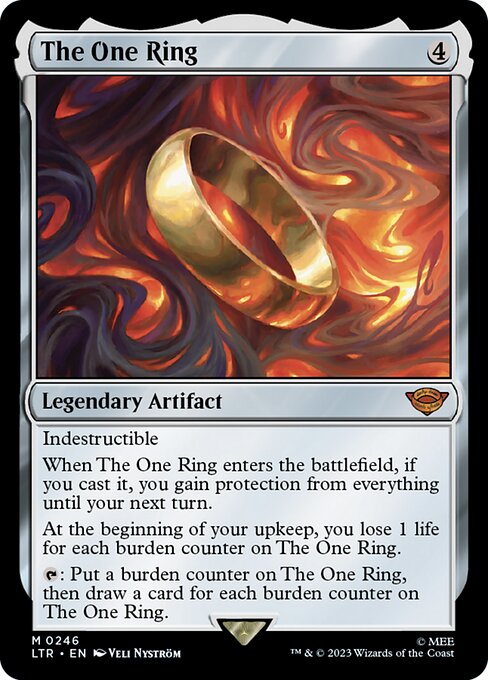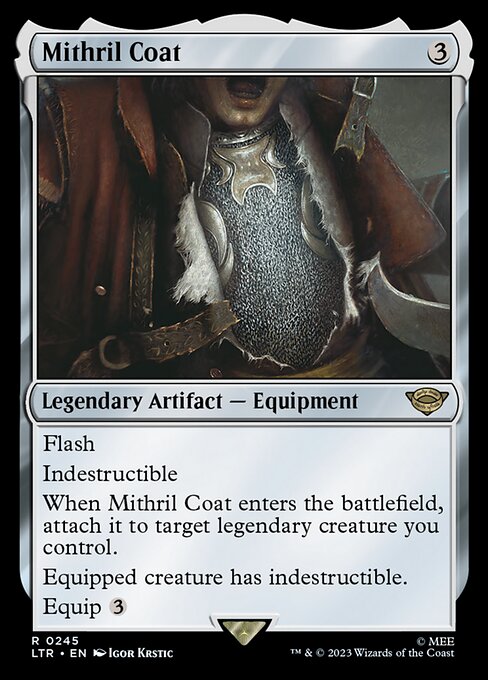Magic: the Gathering: Universes Beyond: Lord of the Rings: Tales of Middle-earth has been out for a couple of weeks now, so we’ve moved from theoretical play to practical play. Tempted by the Ring has not become Modern’s Initiative, Mirkwood Bats hasn’t been banned in Commander, and The One Ring still bides its time in a pallet of Collector’s Boosters in some warehouse (Editor’s note, the One Ring was indeed found in-between when this article was submitted and when it was published). Arachnogenesis now costs almost as much as a Sheoldred, the Apocalypse and Orcish Bowmasters may prove to be a problem, but otherwise, all’s right with the world and copacetic in the Shire.
I’ve been enjoying Tales of Middle-earth Limited and what small vestige of eleven-year-old Rob in my heart remains is delighted at combining my two favorite fantasy worlds. Wizards really trapped lightning in a bottle with this set–I tossed a Starter Kit into the engineering bullpen at work and the resultant disbelief from forty-something former players that “there are Lord of the Rings Magic cards now!?” has amplified my joy. The one ongoing issue–and it’s at least thematically appropriate–is the lopsided power of the rare and mythic Equipment in Tales of Middle-Earth Limited, which engender joy when they’re in your deck and dismay when they’re in your opponent’s.

Equipment is now twenty years old, and has been balanced after a rocky launch–Loxodon Warhammer should not have been an uncommon and Skullclamp should simply not have been–so we’re now accustomed to what it can do and its general rate. Most Equipment is calibrated for Limited outside of the odd Sword or Shadowspear and thus tends not to make the leap to Constructed outside of “Voltron”-style Commander decks or corner cases like Colossus Hammer decks. For the most part, you’d rather run more and better creatures than take a turn off to Equip them, so the Equipment that has seen the most success in Magic either latches on automatically (Embercleave, Mace of the Skyclaves) or is attached with some kind of Puresteel Paladin trickery.
All of which is to say that Equipment rarely sees play in tournament Magic unless it’s doing something unfair–the tempo loss of your creature biting a Go for the Throat right as you tap out to Equip it is brutal. Out of the 450 unique pieces of Equipment printing since 2003, only a few dozen have seen top-level play, but it’s a flavorful and exciting way to make Auras more resilient. Occasionally, as in Middle-Earth, it’s a fantastic way to underline the importance and power of legendary weapons in the narrative and recreate the feeling of the books within the landscape of Magic.
Tolkein’s Middle Earth is lousy with legendary weapons. Even low-level encounters, like the dwarves’ run-in with a trio of trolls early on in The Hobbit, award named swords with thousands of years of history. While named swords track back to Beowulf or before, Tolkein was the one who made them a core component of Western fantasy. Éomer’s Gúthwinë (taking its name from Beowulf), Túrin’s Gurthang, the hammer of the underworld Grond–Tolkein was, above all else, an absolutely huge nerd for language and mythology, and so he plucked inspiration from Finnish and British folklore to flesh out his world. Just as their creators were inspired by J. R. R. Tolkein, we wouldn’t have Dragnipur, Callandor, Stormbringer, Ice, Terminus Est, or any of a hundred other knockoff Nairsils that pop up in fantasy fiction without the Middle-Earth saga.
Tales of Middle-Earth doesn’t have the space to showcase every named sword in the saga, but Wizards chose a representative collection of heroic appurtenances for us to use. There are nine pieces of Equipment printed in the actual set of Tales of Middle-Earth (eight in the draftable set, one in the Starter Kit), but we can discount the nonlegendary bow, the Dúnedain Blade and Barrow-Blade, and, weirdly enough, Gimli’s Axe–of those that remain, we have three Legendary swords, one Legendary ring, and one Legendary mail-shirt.
I truly appreciate the partitioning of the Ring of Power into The One Ring and Bilbo’s Ring and the story it tells. Bilbo used the ring to evade threats, for petty theft, and for pranks, only tapping into the scantest bit of its omnipotence, so of course it would also be a separate artifact from The One Ring. If I drive a M1A1 Abrams to work and never use its martial capabilities, I can’t really count myself as a tank commander. Likewise, Bilbo’s ring protects him–and yet, even with his provincial and limited understanding of its power, it still empowers and saps him, just as The One Ring does for those of us who understand its potency. It’s clever design and faithful to the role of the Ring in Tolkein’s works.
Bilbo’s other bequest is the mithril shirt he handed down to Frodo. Per Gandalf, it’s a “kingly gift,” worth more than the entirety of the Shire and it saves Frodo’s life more than once over the course of the epic. In Magic terms, it’s a souped-up Darksteel Plate. For one more mana to equip, it has Flash and snaps onto a Legendary creature, whether that’s your general or a random Orc who’s become a temporary Ring-bearer. Darksteel Plate has always been highly valued by Commander players, and I don’t expect Mithril Coat to be any different–while it’s not odd that it’s Legendary, considering only one is mentioned in the Lord of the Rings, it is odd that it has such a generic name. “Bilbo’s Heirloom Coat” or “Frodo’s Mithril Coat” would perhaps be a more suitable appellation for a billion dollar artifact that stopped a troll’s spear, a fateful arrow, a fatal stab wound, and an assassination attempt, although since this will mostly see play in Limited and Commander, the odds of having multiple copies out are minimal.

The three Legendary weapons–Glamdring, Sting, and Andúril–are, unsurprisingly, combat-oriented. I’m disappointed we didn’t get Orcrist, known to Goblins as “Biter,” to make the set complete, but by the time of Lord of the Rings, it had been interred with Thorin.
Glamdring, also known as “Beater” to the Goblins it laid low, was the longsword wielded by Gandalf in both The Hobbit and The Lord of the Rings. Like Sting and Orcrist, it gleamed in the presence of Goblins and Orcs to warn its wielder, which is translated into Magic by granting First Strike; notably, unlike Sting, it’s perpetual First Strike, rather than only being active against Orcs and Goblins. Magic’s Glamdring is a Runechanter’s Pike with an upside that ties into Gandalf’s facility with sorcery, for only one more mana to equip. Its fail state–a graveyard without Instants or Sorceries–is common enough that it’s not unbeatable, and the “cast on connect” clause is basically flavor text–if you’re hitting them with a large enough Beater-bearer to make it worth your while, it’s win-more. It’s a good design for Glamdring, though–while Gandalf is competent with a sword, he’s never going to ignore magic in favor of swordcraft–and the decks that need a Runechanter’s Pike aren’t going to be upset to have a backup.
Sting, found with Glamdring in the troll’s caves, is another Elvish blade. A large dagger for a human or elf, it proved to be the perfect size for a Hobbit’s sword. Like the Hobbits themselves, it’s unassuming, with great power hidden within its compact size. Bilbo heroically uses the elf-blade to fend off gigantic spiders in Mirkwood, and, unlike many of the other swords in Lord of the Rings that come loaded with backstories and lengthy legacies, names it himself. It’s a nice moment depicting Bilbo’s courage in which he uses a humble tool for acts of heroism. He later bequeaths it to Frodo on the eve of the Fellowship’s departure:
“He took from the box a small sword in an old shabby leathern scabbard. Then he drew it, and its polished and well-tended blade glittered suddenly, cold and bright. ‘This is Sting,’ he said, and thrust it with little effort deep into a wooden beam. ‘Take it, if you like. I shan’t want it again, I expect.’”
Sting is small but lightweight and nimble, as suggested by the +1/+1 and Haste it affords its wielder, and warns its user of any nearby Goblins (and later, Orcs), as expressed through its First Strike and untap abilities. Cheap to cast, cheap to equip, and useful with any creature with a tap ability, Sting doesn’t look like much, but packs a punch–it’s in my favorite category of Equipment along with Basilisk Collar and Specter’s Shroud.
This brings us to the heaviest hitter: Andúril, named Nairsil before it was shattered in battle against Sauron, which was reforged by Elvish smiths and used by Aragorn in battles throughout The Lord of the Rings. In Magic, Andúril is a monster, granting +3/+1 to its wielder and casting a Shadow Summoning with each attack. I was lucky enough to draft this last week, and, at the same cost to cast and equip, it outclasses Sword of Fire and Ice. In Constructed, it’s not going to measure up, but it’s destined for Cubes and post-draft bad-beats stories for years to come.
In the Peter Jackson films, Andúril, as symbol of the King of Gondor, has the power to compel the spirits of the oath-breaking dead to fight alongside Aragorn and redeem themselves. Magic hews closely to the adaptation, letting any wielder of the blade summon spirits and letting a Legendary wielder lead those spirits into battle. Like Living Weapon, it’s Equipment that provides its own wielder, so even if your Aragorn falls in battle, the Spirits are there to pick up the sword.
It’s amusing that the two most-desired cards from Tales of Middle-Earth are the mythical One Ring that offers unlimited power at the cost of irrevocable corruption and a squad of anonymous orcs with bows, particularly when the set is so loaded with iconic legends and their fantastical equipment. Andúril, the sword that cut through the forces of darkness and brought about the renewal of Gondor, is a Limited bomb and not much else, and Glamdring is basically equivalent to a pike smithed by a random Innistradi iron-monger. I’m more excited about Sting, because I’m sick to death of Swiftfoot Boots and Lightning Greaves, and I’m brewing up a Zimone and Dina deck.
In general, though, I don’t expect to see many of Middle-Earth’s legendary weapons on the other side of the table once the novelty’s worn off. Magic is surprisingly stingy with legendary weapons–only 37 Legendary Equipment card have been printed, expanded to 38 if you include proto-Equipment Sword of the Chosen–so Tales of Middle-Earth adding another half-dozen is a huge advancement, even if they’re more present in annals of heroism rather than the kitchen table. Legendary weapons loom large in Lord of the Rings, and even larger in the long litany of fiction inspired by Tolkein’s epic, but at the end of the day, Bilbo Baggins understood that a sword only serves one purpose, and, like rings, they have to be left behind one day.
Rob Bockman (he/him) is a native of South Carolina who has been playing Magic: the Gathering since Tempest block. A writer of fiction and stage plays, he loves the emergent comedy of Magic and the drama of high-level play. He’s been a Golgari player since before that had a name and is never happier than when he’s able to say “Overgrown Tomb into Thoughtseize,” no matter the format.

